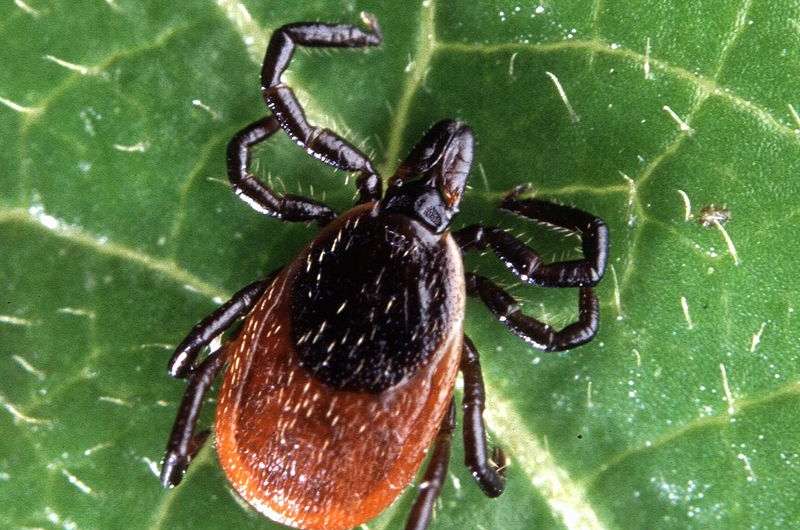Blacklegged tick populations have expanded via migration, biologists show

Lyme disease cases are on the rise, with diagnoses occurring in areas that were historically Lyme-free. Scientists attribute the spread to the fact that populations of blacklegged ticks, which carry the bacteria that causes the disease, now flourish in areas once thought to be devoid of ticks.
In a new study, biologists from the University of Pennsylvania, together with colleagues from the New York Department of Health and State University of New York, used genetic and phylogeographic analyses to determine the origin and recent migratory history of newly discovered tick populations in the Northeastern United States. Their findings indicate that the ticks moved into new areas from established populations, mainly through short-distance, local moves. The results shed light on patterns of disease spread and could have implications for strategies to control ticks in order to reduce disease.
The research was led by Camilo E. Khatchikian, a postdoctoral researcher in Penn's Department of Biology in the School of Arts & Sciences and a member of the lab of Dustin Brisson, senior author and an associate professor of biology. Additional Penn coauthors included Erica Foley and Stephanie N. Seifert from Brisson's lab and Michael Z. Levy, an assistant professor of biostatistics and epidemiology in the Perelman School of Medicine. The Penn researchers collaborated on the work with Melissa Prusinski and P. Bryon Backenson from the New York Department of Health and Melissa Stone and Ing-Nang Wang from the State University of New York in Albany.
The study is published in the journal Evolution.
Since 1975, Lyme disease has been diagnosed in 49 states, with about 300,000 cases a year, concentrated in the Northeast and Midwest. Recent years have seen a dramatic increase in diagnoses. In Pennsylvania, for example, diagnoses rose 25 percent between 2013 and 2014.
A 2012 study by Khatchikian, Brisson and colleagues confirmed a tight association between populations of blacklegged ticks and numbers of human cases and also documented increases in tick populations in areas of the Northeast that were previously thought to not harbor ticks.
"People didn't know where they were coming from," Khatchikian said. "From the point of view of human disease, it doesn't really matter where they come from; the point is that they're here. But when you start thinking about how to control and prevent infections, it matters to know how easily the vectors of the disease are moving."
In the current study, the researchers considered two hypotheses: either the "new" tick populations were actually not new but reflected growth in populations that were previously in the area at undetectable levels, or the populations could have arisen from ticks moving in from other areas, likely by hitching a ride on birds or mammals.
To determine the recent population history of blacklegged ticks in the Northeast, the Penn-led researchers analyzed data collected in four locations in New York's Hudson River Valley between 2004 and 2009. They sequenced portions of the mitochondrial DNA to understand the relationships between tick populations and how they changed over time.
"We took advantage of samples that had been collected through time to give us a window into the past," Khatchikian said.
Their phylogeographic analysis indicates that ticks mainly moved in progressive south-to-north migration events between neighboring locations, with occasional long-distance movements.
Researchers know that migrating birds can transfer ticks over hundreds of miles during their annual movements. But since the majority of movements documented in this dataset took place over short distances, less than 62 miles or 100 kilometers, it is not clear under what circumstances animals were moving the ticks.
Using the genetic data like a "molecular clock," the researchers roughly estimated that the northernmost locations were colonized 14 years ago, the second most northern 31 years ago and the third most northern 40 years ago. These findings are supported by the fact that no ticks were found in the northernmost site when sampling was done in the early 2000s.
The researchers noted that the reason for the population expansion remains unclear. It is possible that the ticks are adapting to new local environments, or that changes in land use and climate are making the new environments more suitable for them.
While more work remains to be done to understand what is driving the movement and expansion of ticks, knowing more about their migrations could help inform efforts to protect the public from Lyme disease.
"From a control perspective, if you know they are moving extremely easily, you could control them in your backyard but they might be back in a week," Khatchikian said. "If we want to reduce tick populations over the long term, this means we have to start thinking about more sophisticated approaches."
More information: Evolution, DOI: 10.1111/evo.12690
Journal information: Evolution
Provided by University of Pennsylvania


















